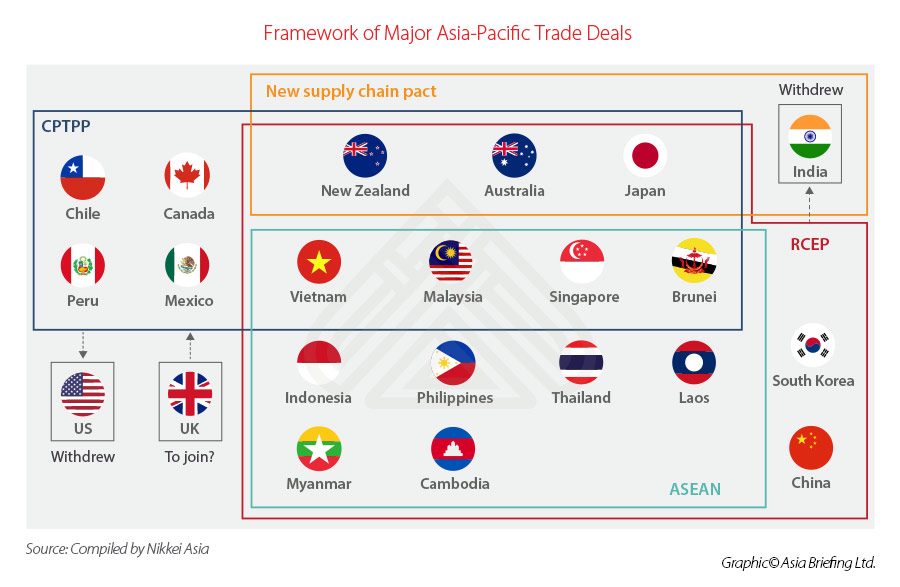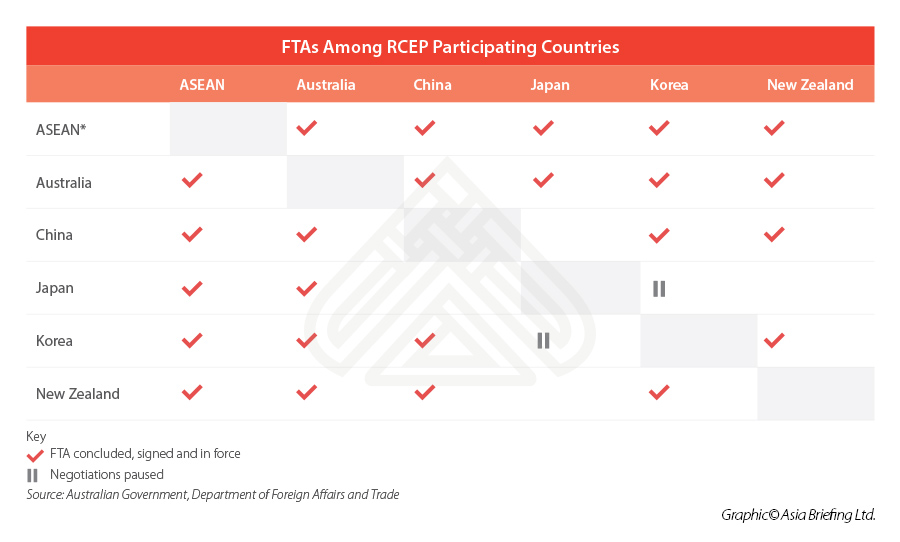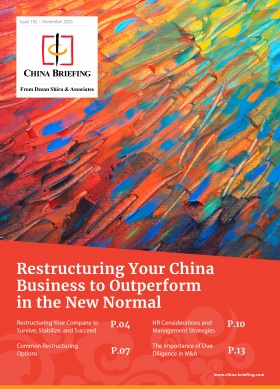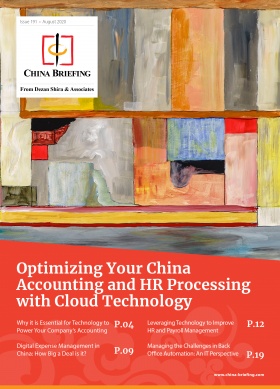RCEP FTA Signed: What Can Foreign Investors in China Expect?
This article was originally posted on March 23, 2020, and last updated on November 9, 2021.
Updates:
- The Regional Comprehensive Economic Partnership (RCEP) has reached the threshold of entry into force and will take effect on January 1, 2022, according to a notice issued by the ASEAN Secretariat, the depositary body of the RCEP, on November 3, 2021. It comes as Australia and New Zealand become the latest member states to ratify the agreement. Other countries that have ratified RCEP include Brunei, Cambodia, Laos, Singapore, Thailand, Vietnam, China, and Japan.
- An official from the International Affairs Department of the Ministry of Commerce said that China is ready to implement RCEP when the agreement goes into effect. In terms of preparations for the implementation of tariff concessions, China completed the transfer of the tariff concessions table and submitted it to the ASEAN Secretariat in the first half of this year. At present, the implementation plan of tax reduction has entered the final stage of domestic approval procedures, which can ensure that the obligation of tax reduction can be fulfilled upon the entry into force of the agreement. In terms of preparation for the implementation of rules of origin, the General Administration of Customs formulated the rules of origin for RCEP and the rules for approved exporters in the first half of this year, which will be announced and implemented simultaneously with the entry into force of the RCEP. In response to country of origin management requirements under RCEP, the upgrade of the information system has been completed.
- On March 22, 2021, China’s Ministry of Commerce announced that China has taken the lead in ratifying the RCEP and the ratification process has been finalized.
- In February 2021, the parliament of Thailand approved the ratification of the RCEP.
- In March 2020, China and 14 other countries signed the Regional Comprehensive Economic Partnership (RCEP) Agreement. Once ratified by six ASEAN countries and three non-ASEAN countries, the pact will formally enter into force by as early as the second half of 2021. RCEP’s sheer size makes it significant. Participating economies account for 29 percent of global GDP and about 30 percent of the world’s population.
On Sunday, March 22, 2020, China and 14 other countries signed the Regional Comprehensive Economic Partnership (RCEP) Agreement at the virtual-hosted ASEAN Summit, formalizing the largest free trade agreement (FTA) in history.
After an arduous eight-year negotiation period, a combination of factors such as slowing global growth, disruption to trade patterns, and US shift away from multilateralism, mobilized participating governments to push ahead with the pact despite long-standing differences. India, however, chose not to join the RCEP although the grouping has left the door open for its future entry.
The landmark agreement consists of 15 countries: 10 member states of the Association of Southeast Asian Nations (ASEAN), China, Japan, South Korea, Australia, and New Zealand.
While China is party to a number of bilateral trade agreements, this is the first time it has signed up to a regional multilateral trade pact.
The primary aim of the RCEP is to establish a comprehensive economic partnership – building on existing bilateral ASEAN agreements within the region with its FTA partners. It will be guided by a common set of rules and standards, lowered trade barriers, streamlined processes, and improved market access.
For investors, RCEP will deliver substantial new trade and investment opportunities within the participating countries – covering roughly 30 percent of the global GDP (US$26.2 trillion) and 30 percent of the world’s population to form Asia’s largest trade bloc to date.
The Chinese Premier, Li Keqiang, described the deal as “a victory of multilateralism and free trade” and stated that the new agreement is “critical to the region’s response to the COVID-19 pandemic.”
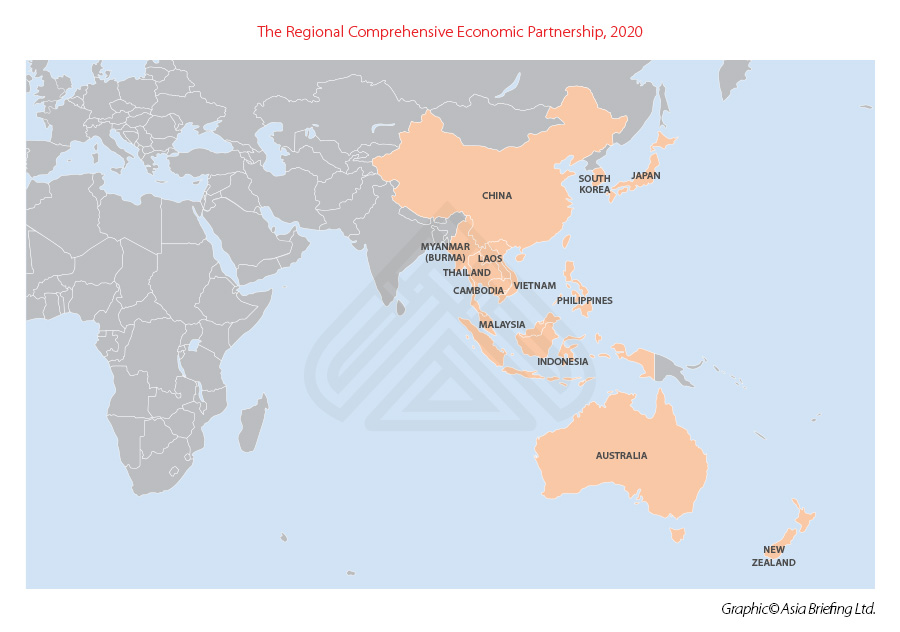
Details of the RCEP agreement
The RCEP agreement includes 20 chapters covering many of the articles typically found in a free trade agreement. Notably, it makes significant strides by way of harmonizing the rules of origin and strengthening IP measures. But some critics have pointed to the weaker commitments for e-commerce and the omission of a labor and environment protection clause, when compared with the CPTPP.
Common rules of origin
One of the most significant changes under RCEP is that the rules of origin will be unified for the entire bloc. This will mean that investors will only require one certificate of origin for trading in the region and can bypass the tedious processes of checking and adjusting to the specific rule of origin criteria in each country. When implemented, investors can expect lower costs, added flexibility, and regional supply chains streamlined.
Trade in goods – reduced tariffs
Under RCEP, tariffs will be eliminated on around 92 percent of goods implemented progressively over the next 20 years, in accordance with each party’s Schedule of Tariff Commitments. This will allow participating countries to gain preferential market access with each other. However, some agricultural and sensitive goods will be excluded from these tariff reductions.
Trade in goods – simplified customs procedure
Simplified customs procedures and enhanced trade facilitation provisions will allow efficient administration of procedures and expeditious clearance of goods, including the release of express consignments and perishable goods within six hours of arrival.
Trade in services
Under RCEP, at least 65 percent of the services sectors will be fully open to foreign investors, with commitments to raise the ceiling for foreign shareholding limits in various industries, such as professional services, telecommunications, financial services, computer services, and distribution and logistics services.
Not unlike the negative list system in China, RCEP will also take on a ‘negative-list’ approach where the market will be fully open to foreign service suppliers, unless it appears on the list. This ensures transparency of regulations and measures which will allow greater certainty for businesses.
Investment
RCEP eases the process required of investors entering, expanding, or operating in RCEP countries. It also prevents the adoption of further restrictive measures and includes a built-in investor-state dispute settlement mechanism that can be evoked by the member states.
Intellectual protection
RCEP raises the standards of IP protection and enforcement in all participating countries. Aside from securing the protection rights for copyright, and trademark in the normal sense, it also goes further to protect non-traditional trademarks (sound marks, wider range of industrial designs) and forms of digital copyright, which goes beyond what was included in the CPTPP.
E-commerce
The agreement covers areas, such as online consumer protection, online personal information protection, transparency, paperless trading, and acceptance of electronic signatures. It also includes commitments on cross border data flows. This provides a more conducive digital trade environment for businesses and provides for greater access to RCEP markets.
Government procurement
Participating RCEP countries have committed to publish laws, regulations, and procedures regarding government procurement, as well as tender opportunities if available. This allows greater transparency for businesses to pursue government procurement market opportunities in the region. RCEP have also committed to a review aimed at improving this in future.
The significance of RCEP for investors in China
RCEP holds great significance for the region, for China, and for foreign investors.
Once implemented it will create the largest trade bloc in Asia and is expected to amount to US$12.4 trillion in trade.
In the region, the pact is monumental not only because it amasses 15 vastly disparate Asian economies and manages to find a common working ground, but it also offers a way to coherently amalgamate multiple bilateral and trilateral trade agreements already in existence – for example, linking together some of the benefits of RCEP, CPTPP, and the New Zealand-Australia-Japan-India New Supply Chain Pact.
For investors operating across ASEAN, China, and other regions – RCEP offers good news. Streamlined customs procedures, unified rule of origin, and improved market access will make investing in multiple location – a much more viable and attractive investment strategy and likely bring “China + 1” business models to the fore. The common rule of origin will lower costs for companies with supply chains that span across Asia and may encourage multinationals to RCEP countries to establish supply chains across the bloc, thus growing the global value chain activity in the region.
This new trading bloc will allso likely see a larger flow of goods from countries where production costs are high, such as Australia, Japan, New Zealand, South Korea, and Singapore to countries with lower labor costs, such as Cambodia, Laos, and Myanmar. The benefit of cheaper goods will spread throughout ASEAN and the other RCEP members as well as filter through to consumers in Europe and the United States.
However, as many RCEP countries already have existing bilateral free trade agreements, the biggest trade impact will be on countries that do not currently have a bilateral agreement between them such as: Japan-China, Japan-South Korea, and Japan-New Zealand.
For China, Japan is its second largest trading partner, after the US, and holds a share of six percent in overall exports and eight percent in imports. According to an analysis by DBS Bank, for China, tariff savings on imports from Japan will amount to a significant US$ 7.3 billion across the segments of transportation equipment, machinery & electrical equipment, chemicals, plastics & rubbers, and metals. However, taking into account China’s size, this will translate to a relatively net impact of 0.05 percent of GDP.
According to estimates by economists at Johns Hopkins University, RCEP will add US$186 billion to the size of the global economy and 0.2 percent to the gross domestic product of its members.
If ratified by six ASEAN countries and three non-ASEAN countries, the pact will formally enter into force, as early as the second half of 2021
About Us
China Briefing is written and produced by Dezan Shira & Associates. The practice assists foreign investors into China and has done so since 1992 through offices in Beijing, Tianjin, Dalian, Qingdao, Shanghai, Hangzhou, Ningbo, Suzhou, Guangzhou, Dongguan, Zhongshan, Shenzhen, and Hong Kong. Please contact the firm for assistance in China at china@dezshira.com.
We also maintain offices assisting foreign investors in Vietnam, Indonesia, Singapore, The Philippines, Malaysia, Thailand, United States, and Italy, in addition to our practices in India and Russia and our trade research facilities along the Belt & Road Initiative.
- Previous Article Q&A: How to Understand the Implementation of the PIPL in China?
- Next Article What is the Ratification Status of the RCEP Agreement and When Will it Come into Effect?

